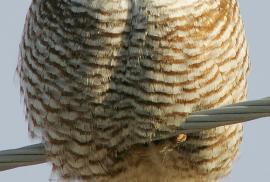Guide to Boreal Birds
Overview
In the northern domain of this fast-flying owl the sun seldom sets during the summer half of the year. Adapted to these conditions, this is the most diurnal of all North American owls. It feeds on rodents, including mice and lemmings, that are active throughout the 24-hour day. In winter, when rodent runways are deep beneath the snow, it eats more birds, including grouse, than mammals. Because it does not depend on any one source of food, it is seldom subject to forced population shifts like other northern predators. Like many northern birds that have rarely seen humans, the Northern Hawk Owl can be exceedingly tame.
Description
15-17" (38-43 cm). W. 33" (84 cm). Smaller than a crow. A long-tailed, day-flying owl that behaves more like a hawk. Barred breast; facial disks have bold black borders.
Voice
Whistling ki-ki-ki-ki-ki-ki, similar to call of a kestrel.
Nesting
3-7 white eggs in a tree cavity, in an abandoned bird's nest, or (rarely) on a cliff.
Habitat
Clearings in boreal coniferous forest and muskeg.
Range/Migration
Resident from Alaska east to Labrador and south to British Columbia, Newfoundland, and Gaspe Peninsula. May wander farther south in winter. Also in Eurasia.



